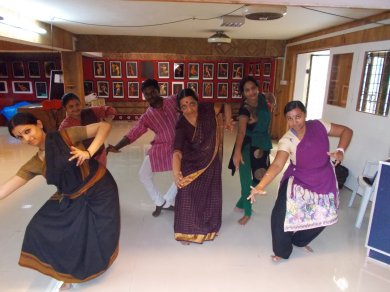
|   |

|   |
Workshop on Kuchipudi Tarangam - Srividya Angara Sinha e-mail: srividya.angara@gmail.com July 25, 2014 Lakshmi Mani, founder-director of Mani Manjeera, a dance school based out of Chennai who is one of the principal disciples of the Kuchipudi doyen Vempati Chinna Satyam, conducted a workshop on Kuchipudi Tarangam on the 12th and 13th of July 2014 in Bangalore. It was organized by the Panchamavedam Foundation and Ananya of Bangalore.  The need for such workshops was very subtly brought out by the trustees of Panchamavedam Foundation. “In a metro like Bangalore where many artists who had learnt the art form elsewhere settle down or move to a city for various compelling reasons like work, marriage, etc, find it difficult to continue their tutelage under their guru stationed in a different place and therein comes the need for workshops conducted by eminent artists. The workshops help the artists to both increase their repertoire and also continue to learn the nuances of the art form from experts thereby honing their skills further.” This workshop provided a good experience on study of subtlety and sublimity of abhinaya. The workshop featured a very rare piece, a Tarangam composition on Lord Venkateswara of Tirupathi, a pleasant surprise for one who is more used to the much popular Tarangams which are generally in praise of Lord Krishna. That the 12th of July happened to be Guru Purnima was surely a sign that one was in the right place, at the right time, dancing to the lyric of “Jaya jaya Srinivasa.” The choreography was by Lakshmi Mani and the story that she chose to delineate spoke of three main characters – a doddering old man, a strapping youth, and a third middle aged one. The old man is Hathiram Bavaji, the lord’s staunch bhakta, the strapping youth is the lord himself as depicted in the Vamana avatar, and third character is the head priest of the temple. To appreciate the uniqueness of the Tarangam it is imperative that one goes into the detail of the stories interwoven in it: Bavaji is visited by Lord Balaji who invites his devotee to a game of dice, which incidentally the bhakta wins. Bavaji is rewarded with a necklace, which the very next day is found missing by the head priest. Bavaji innocently points out that it is not lost and that it is with him. The priest disbelieves him and brands him a thief. To further humiliate him, he confines him to a room filled with sugarcane and challenges his devotion, ordering him to eat up all the sugarcane by the next morning. The gracious lord then assumes the form of an elephant who after polishing off all the sugarcane trumpets his presence to the sleeping priests. Waking up to the din and realizing that it is originating from Bavaji’s cell, the priests makes a beeline for it. Upon opening it, there is not even a single shaft of sugarcane left, seeing which the priest falls at Bavaji’s feet and begs for forgiveness. The body language of the three different characters so marked, so distinct taught by Lakshmi Mani as the old man Bavaji with shuffling gait, slightly bobbing head, the occasional clutching of the bent knees and then twirling around to become the Lord Supreme, and a little later into the disbelieving, slightly arrogant head priest – it was definitely a great lesson in various aspects of abhinaya. The rest of the Tarangam in praise of the beautiful feet of the lord was depicted to ascribe the various deeds of the lord through his different avatars, followed by nritta on the brass plate, as is customary in a Tarangam. Performing and teaching of this item by Lakshmi Mani in a very lucid, aesthetic manner to the melodious live singing of Naveena throughout the workshop in the tranquil surroundings at Ananya made a perfect picture for one to gain a lot from the workshop, making one look forward to many such workshops in the future. |